|
CHOOSING THE BEST MARINE PROPELLER
There
are many exotic ways of generating thrust in water:
Caterpillar drives, fish-tails, paddles, thrusters, etc. But, when it
comes down to it, a good propeller is more cost effective,
reliable and available. So what is a good propeller?
The answer to that is: the one for the job.
However, there
are so many applications one must choose carefully -
prioritise. Most commercially available propellers
only achieve 40-50% efficiency. Unfortunately,
this is nowhere near enough to enable the Elizabeth
Swann to
tackle the high seas using only renewable
energy.
|
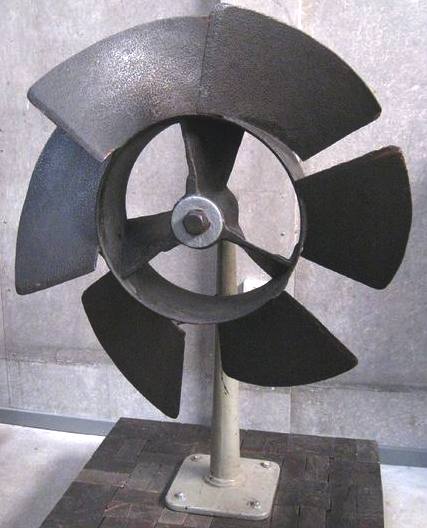
|

|

|
|
Erricson's
propeller 1842 |
A
wooden airscrew propeller |
Bronze
propeller from the Lusitania |
HISTORY Long
before there was any practical application it was
discovered that a flat plate pushed through the air at
an angle created lift. Of course a flat plate is
not very efficient. Marine
propellers work on the same principles.
Except that air is many times less dense than water and
water is virtually incompressible. Credit for the
invention of the marine screw propeller comes down to
two men: Francis petit Smith and John Ericsson. In
1836, both Smith and Ericsson obtained patents
for screw propellers of different designs. An
accident led to the discovery a shortened Archimedain
screw was more efficient where a collision on the
Paddington Canal swept away half of Smith's propeller
and as a result the boat actually gained speed. Originally, the wooden
propeller had been two complete turns. In
1839 I. K. brunel changed the design of the Great
Britain to screw propulsion. This iron boat could
acheive 11 knots with 1,500 horspower. Also in
1839 George Rennie patented his Conoidal propeller which
combined the ideas of increased pitch and multiple
threads. Then in 1869 C. Sharp of Philadelphia,
Pennsylvania patented a partially submerged propeller
with high pitch and cupped blades. Later the Wright Brothers
built a wind tunnel to develop a practical wing
shape. After testing hundreds of wing shapes they discovered an aerofoil section worked
best and formulated an efficient chord to length ratio
for their biplane wings, such as to enable the first
genuine powered flight.
James Watt of Scotland is generally credited with applying the first screw propeller to an engine at his Birmingham works, an early steam engine, beginning the use of
a hydrodynamic screw for propulsion.
Mechanical ship propulsion began with the steam ship. The first successful ship of this type is a matter of debate; candidate inventors of the 18th century include William Symington, the Marquis de Jouffroy, John Fitch and Robert Fulton, however William Symington's ship the Charlotte Dundas is regarded as the world's "first practical steamboat". Paddlewheels as the main motive source became standard on these early vessels (see Paddle steamer). Robert Fulton had tested, and rejected, the screw propeller.
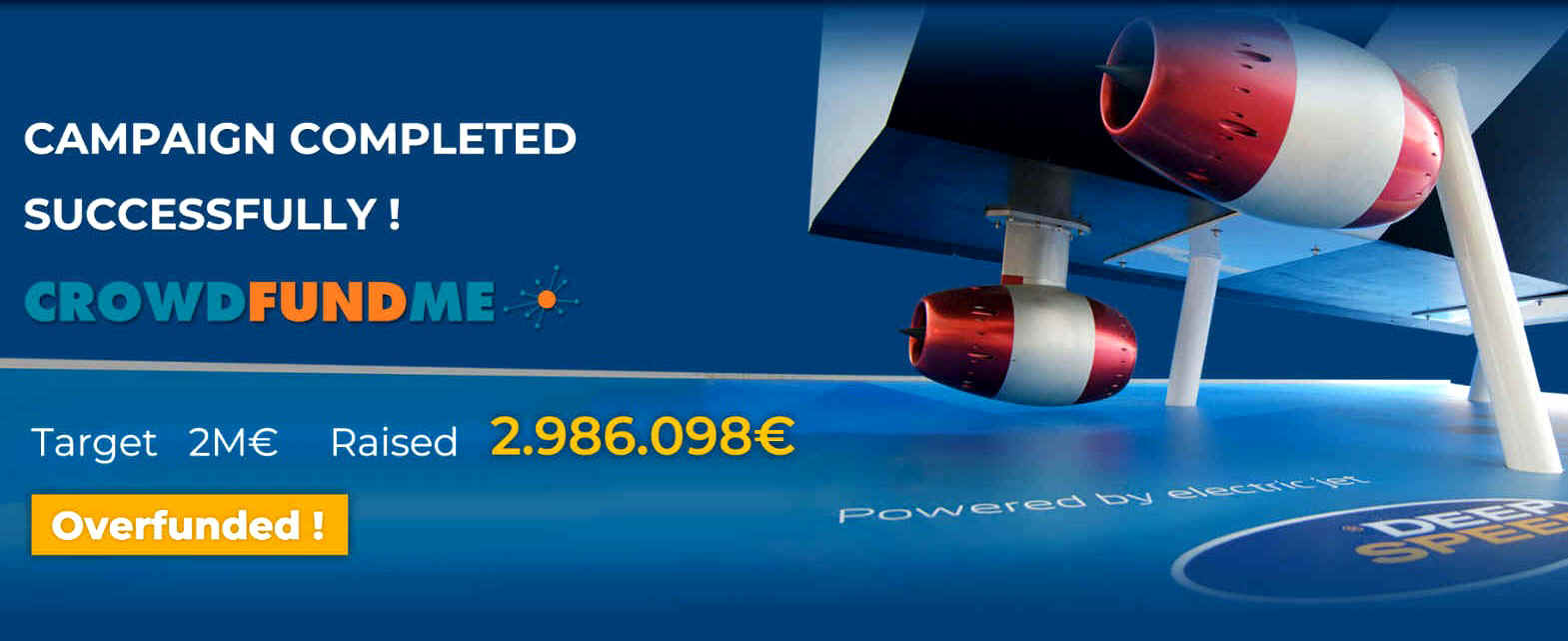
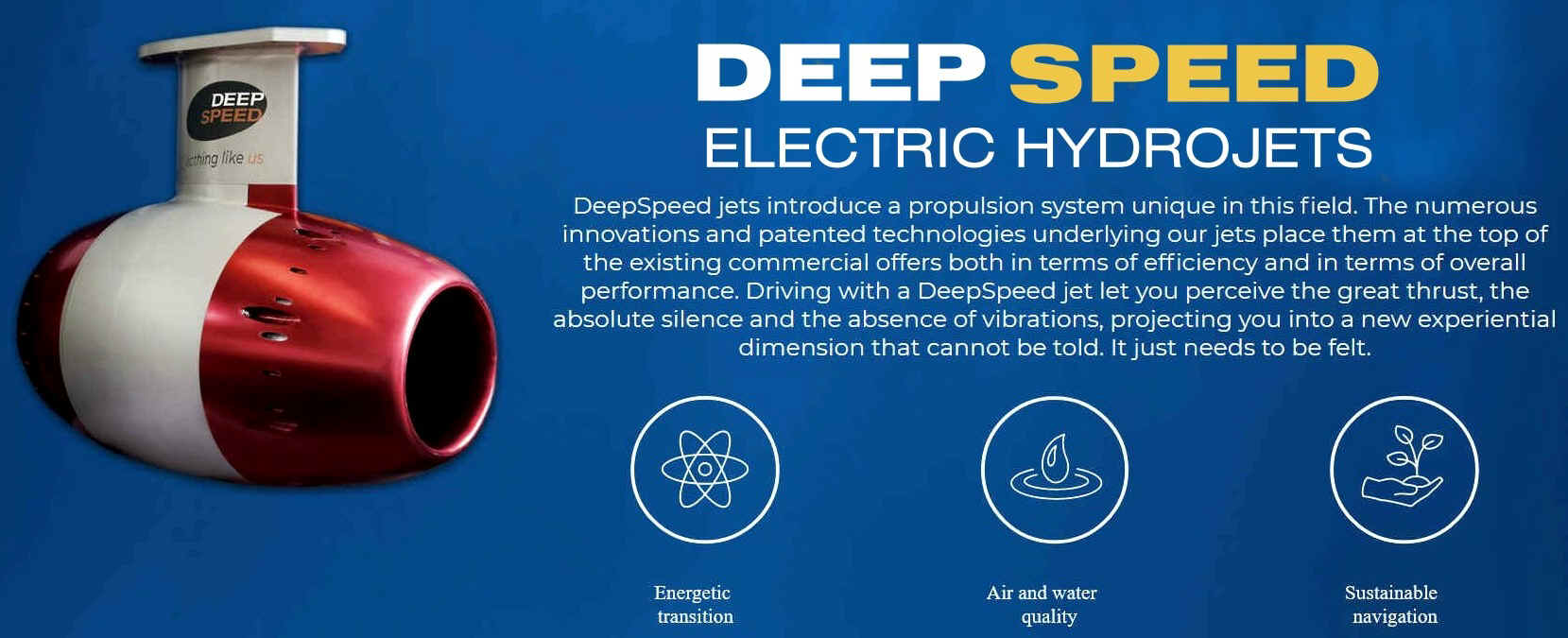
DEEP
SPEED -
From an idea to a product in record time, these electric hydro-jets from
Sealence in Italy are the business. In the coming age of zero emission
shipping, they hold the potential to revolutionize solar and wind powered
shipping, and hybrid yachts, tolling the death knell to conventional
propellers in many applications. In 2021 the company raised nearly €3
million Euros, to set them on the road to production. The Elizabeth Swann is
set to use these drives to get the most from renewable energy harvested form
nature.
The screw (as opposed to paddlewheels) was introduced in the latter half of the 18th century. David Bushnell's invention of the
submarine (Turtle) in 1775 used hand-powered screws for vertical and horizontal propulsion. The Bohemian (Austrian Empire) engineer Josef Ressel designed and patented the first practicable screw propeller in 1827. Francis Pettit Smith tested a similar one in 1836. In 1839, John Ericsson introduced practical screw propulsion into the United States. Mixed paddle and propeller designs were still being used at this time (vide the 1858 Great Eastern).
The screw propeller replaced the paddles owing to its greater efficiency, compactness, less complex power transmission system, and reduced susceptibility to damage (especially in battle)
Initial designs owed much to the ordinary screw from which their name derived - early propellers consisted of only two blades and matched in profile the length of a single screw rotation. This design was common, but inventors endlessly experimented with different profiles and greater numbers of blades. The propeller screw design stabilized by the 1880s.
In the early days of steam power for ships, when both paddle wheels and screws were in use, ships were often characterized by their type of propellers, leading to terms like screw steamer or screw sloop.
Propellers are referred to as "lift" devices, while paddles are "drag" devices.
SIZING
Marine
propeller sizes are always specified by diameter
and pitch (diameter x pitch) with the diameter
dimension specified first. For example: a 15 x 12 propeller has a
15" diameter and a 12" pitch. Normally, these are the only
dimensions given in a prop size, which is
unfortunate because there are other
characteristics of the prop you need to consider
when selecting the size. You should always start
your search with the diameter and pitch of the
prop first then work from there.
PITCH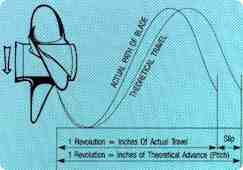
Pitch is measured in inches and it is a
theoretical measure of how far the propeller
should move through the water in one revolution if
there was no slippage at all. For example, an
18" pitch prop would move 18" forward in
one revolution (provided there was no slippage).
The primary effect of pitch on your
performance is the same as the gear-shift in your
car. Higher pitch numbers are like the higher
gears (4th and 5th) in your car, more speed but
less acceleration. Lower pitches are like lower
gears (2nd and 3rd): more acceleration but less
top speed.
DIAMETER
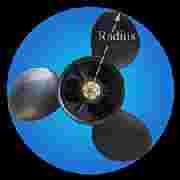 Diameter is just what you think it is: the
diameter of the spinning prop. You can quickly
check the diameter by measuring from the center of
your prop nut to the tip of one of your prop
blades. Double the number you get to get your
diameter. Diameter can influence the speed you
get, but it has its greatest affect on your
acceleration and thrust. Bigger diameter is like
adding bigger tires to your car: more traction or
more appropriately, less slip. Larger diameters
put more load on your motor because they move more
water though so don't over do it. A blade moving
through water does experience drag. The less
blade there is (less diameter), the less the drag
will be. Provided your motor and prop produce
enough thrust, when you decrease your prop
diameter your speed will increase a bit because
there is less drag. Diameter is just what you think it is: the
diameter of the spinning prop. You can quickly
check the diameter by measuring from the center of
your prop nut to the tip of one of your prop
blades. Double the number you get to get your
diameter. Diameter can influence the speed you
get, but it has its greatest affect on your
acceleration and thrust. Bigger diameter is like
adding bigger tires to your car: more traction or
more appropriately, less slip. Larger diameters
put more load on your motor because they move more
water though so don't over do it. A blade moving
through water does experience drag. The less
blade there is (less diameter), the less the drag
will be. Provided your motor and prop produce
enough thrust, when you decrease your prop
diameter your speed will increase a bit because
there is less drag.
NUMBER
OF BLADES


 How many blades
should your prop have? Three blade
propellers are the most common, but 4 and
even 5 blade props are available.
The immediate benefit to increasing your
propeller's blade count is increased thrust and a
smoother ride (Much like adding more cylinders to
your engine). Theoretically, the more blades
the lower the efficiency of the propeller.
How many blades
should your prop have? Three blade
propellers are the most common, but 4 and
even 5 blade props are available.
The immediate benefit to increasing your
propeller's blade count is increased thrust and a
smoother ride (Much like adding more cylinders to
your engine). Theoretically, the more blades
the lower the efficiency of the propeller.
However, increased blade count generally means that each
blade no longer has to deal with as much
horsepower and consequently the blades can be made
a bit thinner which improves their individual
efficiency. For example, on a three blade prop
running on a 300HP motor, each blade has to handle
a 100 hp each. On a 4 blade prop on the same
motor, each blade only has to handle 75 HP! This
allows the designer to build a prop with a thinner
blade without sacrificing stiffness or strength.
Unfortunately, the overall efficiency of a
multi-bladed propeller is reduced when the
blades are forced to run through confused waters -
increasing drag. Equally, drag rises to the square
(approximately) of speed. Also, a narrow
blade, just like a thinner blade passes through
the water with less drag. Ideally,
therefore, we want a thin section, narrow twin
blade, revolving as slowly as possible.
Which is just not practical for most boating
applications.
CUPPING
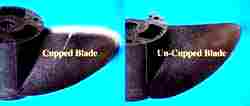 Cupping is added to most propeller blades to
improve the propeller's bite on the water and
decrease slippage. It is most commonly seen on the
trailing edge of the blade. Usually the effect of
cupping makes the prop perform like a higher pitch
propeller, but it does enhance your thrust as
well. In addition, cup reduces a prop's tendancy
to ventilate or slip. Custom prop builders often
use aggressive degrees of cupping to fix slippage
problems on large diameter, low pitch props on
certain boating applications. Cupping is added to most propeller blades to
improve the propeller's bite on the water and
decrease slippage. It is most commonly seen on the
trailing edge of the blade. Usually the effect of
cupping makes the prop perform like a higher pitch
propeller, but it does enhance your thrust as
well. In addition, cup reduces a prop's tendancy
to ventilate or slip. Custom prop builders often
use aggressive degrees of cupping to fix slippage
problems on large diameter, low pitch props on
certain boating applications.
Most props you will encounter are cupped. Most
likely, you will only see an uncupped propeller in
performance applications. On smaller outboards,
which produce most of their power in the upper
third of their RPM range, an uncupped prop with a
semi-cleaver design often produces better
performance. To get maximum performance, it is
necessary to get the motor spinning up in this
range as quickly as possible. An uncupped prop
loads the motor a bit less, allowing the rpm to
build more quickly. This enables you to operate
your motor in the meat of its powerband where
you'll get maximum power. You will notice faster
hole-shot, quicker acceleration, and often times,
higher top speeds with these semi-cleaver,
uncupped style blades. If you are currently
running a cupped style propeller and
want to improve your overall performance consider
trying a semi-cleaver design. Generally, when
switching to an uncupped semi-cleaver style prop,
you can up the pitch 2 inches and still have
better hole-shot, quicker acceleration and often
better top speed! Cup can also provide
additional bow lift when utilized on the rake line of
the prop.
Applying cup to the trailing edge of the prop
along the pitch line will increase the effective pitch
of the propeller. A standard cup will typically result
in a decrease of 200 to 400 rpm's. This usually means a
decrease in pitch of 1 to 2 inches is required to run a
cupped propeller in place of an uncupped wheel.
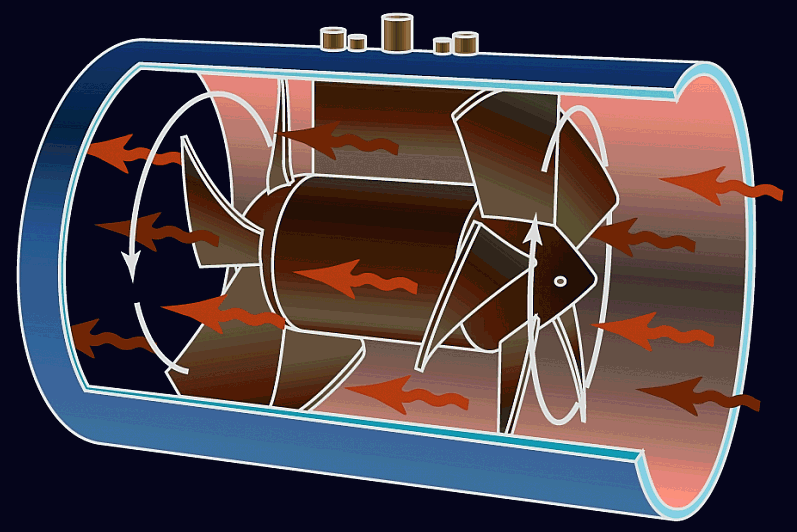
CONTRA
ROTATING IMPELLERS - Traditional single propeller systems generate
thrust by accelerating water in the axis of the propeller shaft. However,
the water discharged by the propeller also rotates. This is due, in part, to
the friction between the surface of the propeller and the water. This
rotational component does not produce thrust, but it does consume energy. By
turning the propellers in opposite directions, the efficiency of the a
thruster becomes 10 to 15% greater than that of single propeller systems.
This has to be offset by frictional losses in the bearings and gears, but
overall there is a gain with additional cost and complexity. Another method
used to increase the efficiency of water (jet) pumps is a fixed stator. Torpedoes
that have to travel at high speed use contra-rotating propellers for this
reason.
BLADE
RAKE
Blade
Rake represents the angle of attachment of the
blade to the hub of the propeller. This is not
to be confused with the pitch, which is a
measure of the twist or screw progression.
The amount of rake built into a propeller blade is
not something many people consider when buying a
new prop, but it can be just what the Dr. ordered
in some cases. Rake angle isn't an immediately
apparent thing to the untrained eye, but if the
propeller blade is cut down the cent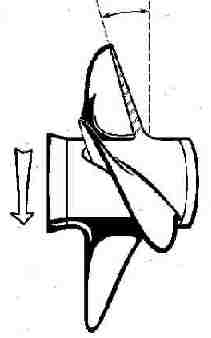 er, it is
readily apparent. The biggest benefit
of a high rake design is a greater resistance to
ventilation. This allows you to trim the outdrive
up toward the surface more without the prop
ventilating as readily during tight manuevering.
You should seriously consider using a high rake
propeller if ventilation is a problem for you. er, it is
readily apparent. The biggest benefit
of a high rake design is a greater resistance to
ventilation. This allows you to trim the outdrive
up toward the surface more without the prop
ventilating as readily during tight manuevering.
You should seriously consider using a high rake
propeller if ventilation is a problem for you.
If you have a large boat like a house or deck boat
a high rake prop may not be the best choice
because it does not produce as much reverse
thrust. This may reduce your ability to manuever
your vessel at low speeds making your boat more
difficult to dock.
Higher rake normally improves performance in
ventilating or cavitating situations (high
engine elevations and high trim angles).
Additionally, higher rake can provide higher bow
lift, which will frequently improve speed. Low
rake blades are typically used on motors with
propellers running fully submerged, typically
carrying moderate to heavy loads. The rake angle
can either be straight or the average angle of a
parabolic curve.
EFFICIENCY
Not
many manufacturers quote the efficiency of their
propellers and even fewer customers ask. The
efficiency of a propeller is defined as the power
coming out of a prop divided by the power going
in:
Power
out
--------------
X 100
For a solar powered boat, efficiency is probably
the most important statistic.
Power
in
BLADE
THICKNESS
(thinner blades cut better)
Why is
Stainless Steel the first choice for high
performance props? A: It is much stronger and far
stiffer than aluminum, but that's not the whole
answer. The higher strength of stainless means
that the blades can be made thinner and that is
where the performance benefit comes from: thin
blades slice through the water more efficiently
than thicker blades. As a result stainless props
produce a couple more mph over even the best
aluminum designs.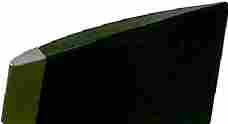
This Design
concept is part of the reason our 4-Blade
propellers and our uncupped "XB" style
3-Blade propellers outperform our Standard 3-Blade
Designs. By incorporating a thinner blade
cross-section, those props cut through the water
with less resistance. There is a compromise to be
made though and that compromise is in durability.
The thinner blades are faster, but they are not as
durable as our thicker blade designs. If you run
up and down a shallow river and hit things
frequently, you may be happier sacrificing some
performance to run the tougher blades. If you
typically run in the ocean with little chance of a
strike, you may prefer the added speed of our
thinner blades.
WHIRL WIND AIR
BOAT PROPELLERS
Whirl Wind AB Series
of airboat propellers are designed for maximum
performance and durability. The
AB series offers excellent all-around
performance; and for those times you
might need that extra boost, it has the static
thrust you require.
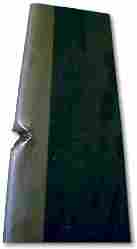
With the serious airboater in mind, the AB
Series has been designed to make pitch
change in the field quick and easy - just
minutes, 1 tool, 1 person and you're off!
And because the blades are modular, you can
replace individual blades when needed rather
than replacing the whole propeller system.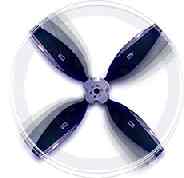
Whirl
Wind
has been producing propeller products for
Unlimited category aerobatic champions and
top airshow performers, as well as for the
U.S. Air Force Unmanned Aerial Vehicles (UAV).
With this rich engineering and composite
manufacturing background, Whirl Wind has
applied their know-how in aviation to the
airboat world with the development of the
all-composite airboat propeller system - the
AB Series. The AB Series is
an airboat
propeller system with graphite
composite blades, offered in two,
three or four bladed designs and available handed to
eliminate sideways thrust (on twin engine setups).
mailto:wwpc@whirlwindpropellers.com?subject=airboat
propeller question
Thick Nickel Leading Edges: Nickel is twice as hard as stainless steel, and
has superior abrasion and impact resistance. A
protective metal leading edge can save composite propeller blades
from destruction should driftwood, etc, go through the propeller --
in this case a 5/8" wrench.
This blade was able to be repaired to like-new
condition for just under $100. Foreign object
damage like this would destroy most any other
composite propeller.
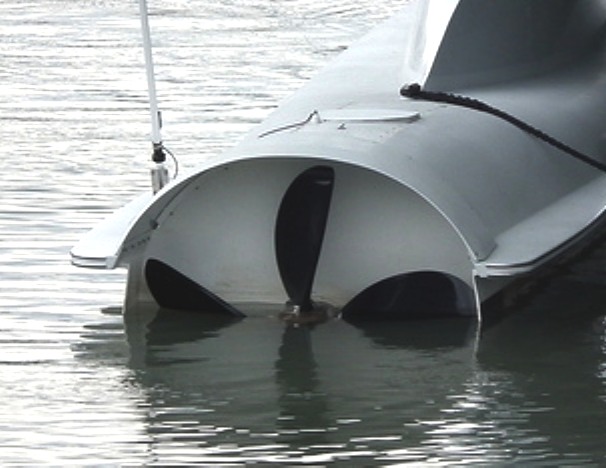
Unusual
variable pitch surface piercing propeller on the Turanor PlanetSolar
ELIZABETH
SWANN'S DESIGN COMPROMISE
As
mentioned above, the
propellers on the Elizabeth
Swann must be efficient above
all. We are looking to achieve 70%
efficiency. So far our tests have exceeded our
target figure up to about one third full size.
Hence we are quietly confident. Having said this
our technical members will not be completely happy until
a full size propeller demonstrates the same efficiency. The
basic theory of propellers tells a single bladed prop is
theoretically the most efficient. In practice a twin
blade is the most practical to reduce vibration. The more blades the
more each other blade introduces turbulent flow into the
equation. The slower a blade moves through the
water the less the drag and the smaller a blade's surface
area, (narrow) the less the frictional drag. It
would seem from the above we are looking for a slowly
revolving propeller with low drag and a small surface
area. Provided we know the speed our vessel will
cruise and the thrust needed to overcome hull drag, we
can then calculate for the most efficient
propeller. Again, this is not quite so straight
forward because there are size and other mechanical
limitations. For this reason commercial propellers
usually have three small blades revolving at quite high
speeds of 3,000 rpm or more. On the other end of
the scale we have huge Tug propellers revolving @ only
500 rpm. The
material a propeller is made from can seriously improve
its performance. For example, a cast aluminium
propeller will corrode more and have thicker sections
than a stainless steel prop. Then again the
stainless prop will cost more. In some
applications carbon fibre is cost effective, as in human
powered craft. Assuming
cost will not prevent the use of exotic materials, the
blade section, pitch and swept area are important to
producing the right propeller for the job. No
doubt we will experiment with quite a few full size
props in deciding on the final pair.
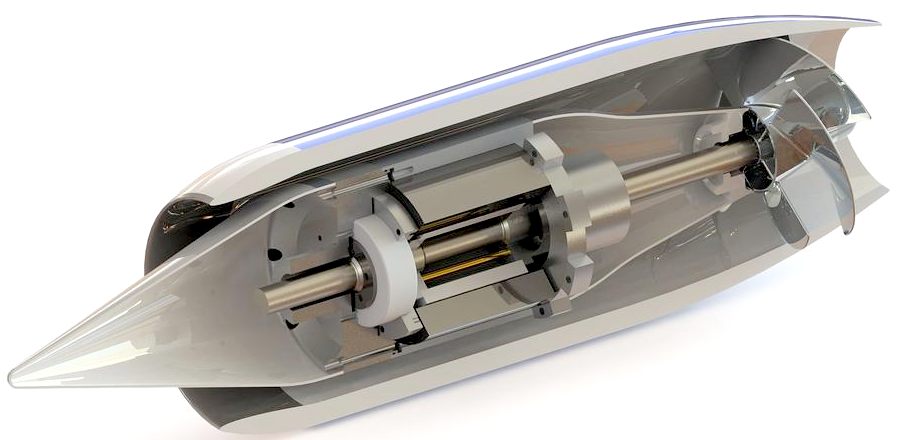
LINKS
& REFERENCE
http://sut.org/
http://lianinno.com/underwater-thrusters/
https://www.marinelink.com/news/breakthrough-electrical354225
https://www.ilsole24ore.com/art/deepspeed-l-idrogetto-elettrico-che-mandera-pensione-l-elica-AC9KCid
https://www.copenhagensubsea.com/
https://plugboats.com/an-italian-hydrojet-to-revolutionize-electric-boats/
https://plugboats.com/amazing-new-electric-boat-motor-based-on-fish-fins/
https://en.wikipedia.org/wiki/Underwater_thruster
https://en.wikipedia.org/wiki/Pump-jet
https://www.instructables.com/id/ROV-Thruster-105-Lbs-From-DT700-Brushless-Motor/
http://www.gepowerconversion.com/
PROPELLER
LINK PAGE
ZERO
EMISSION YACHT - The Elizabeth Swann is a solar and wind powered
trimaram. Probably the most advanced vessel in the world technologically.
A
taste for adventure

A
heartwarming adventure: whalers V conservationists, with a happy ending
for all
|
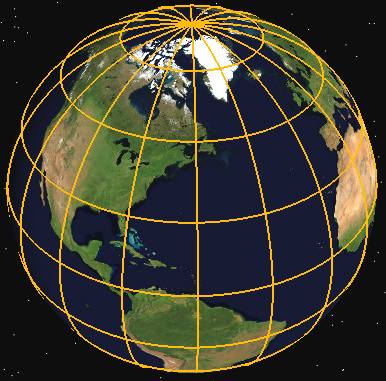






 Diameter is just what you think it is: the
diameter of the spinning prop. You can quickly
check the diameter by measuring from the center of
your prop nut to the tip of one of your prop
blades. Double the number you get to get your
diameter. Diameter can influence the speed you
get, but it has its greatest affect on your
acceleration and thrust. Bigger diameter is like
adding bigger tires to your car: more traction or
more appropriately, less slip. Larger diameters
put more load on your motor because they move more
water though so don't over do it. A blade moving
through water does experience drag. The less
blade there is (less diameter), the less the drag
will be. Provided your motor and prop produce
enough
Diameter is just what you think it is: the
diameter of the spinning prop. You can quickly
check the diameter by measuring from the center of
your prop nut to the tip of one of your prop
blades. Double the number you get to get your
diameter. Diameter can influence the speed you
get, but it has its greatest affect on your
acceleration and thrust. Bigger diameter is like
adding bigger tires to your car: more traction or
more appropriately, less slip. Larger diameters
put more load on your motor because they move more
water though so don't over do it. A blade moving
through water does experience drag. The less
blade there is (less diameter), the less the drag
will be. Provided your motor and prop produce
enough  Cupping is added to most propeller blades to
improve the propeller's bite on the water and
decrease slippage. It is most commonly seen on the
trailing edge of the blade. Usually the effect of
cupping makes the prop perform like a higher pitch
propeller, but it does enhance your thrust as
well. In addition, cup reduces a prop's tendancy
to ventilate or slip. Custom prop builders often
use aggressive degrees of cupping to fix slippage
problems on large diameter, low pitch props on
certain boating applications.
Cupping is added to most propeller blades to
improve the propeller's bite on the water and
decrease slippage. It is most commonly seen on the
trailing edge of the blade. Usually the effect of
cupping makes the prop perform like a higher pitch
propeller, but it does enhance your thrust as
well. In addition, cup reduces a prop's tendancy
to ventilate or slip. Custom prop builders often
use aggressive degrees of cupping to fix slippage
problems on large diameter, low pitch props on
certain boating applications.
 er, it is
readily apparent. The biggest benefit
of a high rake design is a greater resistance to
ventilation. This allows you to trim the outdrive
up toward the surface more without the prop
ventilating as readily during tight manuevering.
You should seriously consider using a high rake
propeller if ventilation is a problem for you.
er, it is
readily apparent. The biggest benefit
of a high rake design is a greater resistance to
ventilation. This allows you to trim the outdrive
up toward the surface more without the prop
ventilating as readily during tight manuevering.
You should seriously consider using a high rake
propeller if ventilation is a problem for you.




